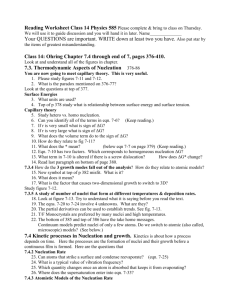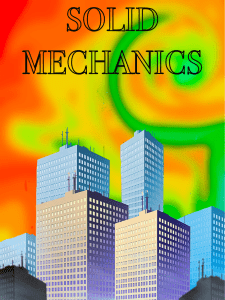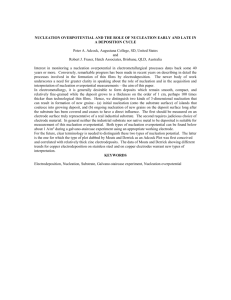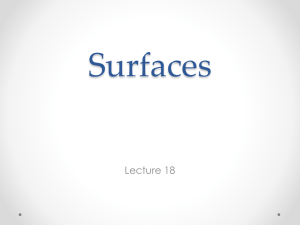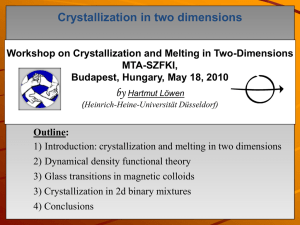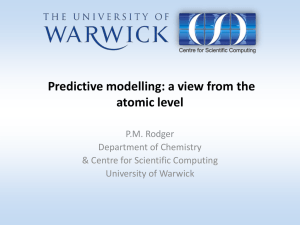APL-mater-Supplement_revision
advertisement
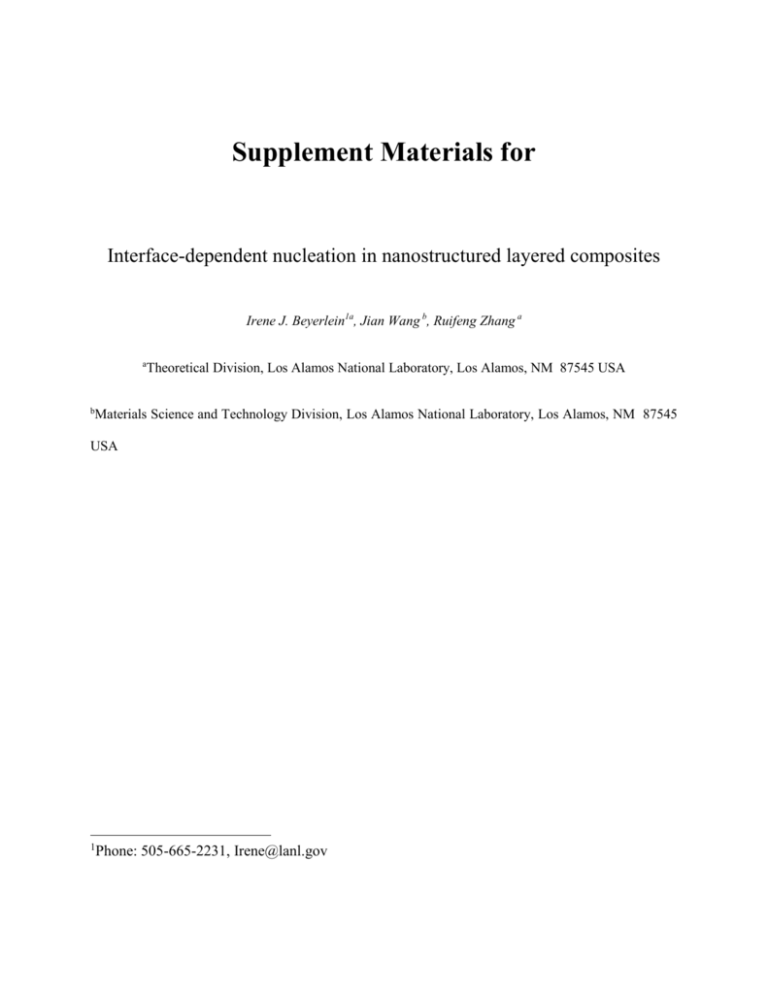
Supplement Materials for Interface-dependent nucleation in nanostructured layered composites Irene J. Beyerlein1a, Jian Wang b, Ruifeng Zhang a a Theoretical Division, Los Alamos National Laboratory, Los Alamos, NM 87545 USA b Materials Science and Technology Division, Los Alamos National Laboratory, Los Alamos, NM 87545 USA 1 Phone: 505-665-2231, Irene@lanl.gov Figure S1. The Thompson tetrahedron providing the relationship and nomenclature for the Shockley partial dislocation systems in an fcc crystal. Extension of Equation 5. Equation (5) is a first-order expression. A more refined expression weights the alignment of a given LD (j) with an ID (i) with the magnitude of the ID (i): (𝑖) (𝑖) (𝑗) (𝑖) (𝑖) (𝑗) (𝑖) (𝑖) (𝑗) 𝐻 𝑖𝑗 = |𝑏⃑𝐼𝑒 |𝑝⟨𝑏⃑𝐼𝑒 ∙ 𝑏⃑𝑃 ⟩ + |𝑏⃑𝐼𝑠 |(1 − 𝑝)⟨𝑏⃑𝐼𝑠 ∙ 𝑏⃑𝑃 ⟩ + |𝑏⃑𝐼𝑁 |⟨𝑏⃑𝐼𝑁 ∙ 𝑏⃑𝑃 ⟩ (S.1) Estimation of the critical angle c. Orowan’s law for the stress to bow out a dislocation segment with Burgers vector of value b between two pinning points with spacing L is given by = b/L (S.2) For room temperature conditions, the shear modulus is 48 GPa for Cu. For the current model, let be the angle between the trace of the glide plane of b on the interface plane and the ID line (i). Within the ID network, the ID line (i) will intersect another ID array (j) at regular points, spaced apart. According to the above, the stress required to bow out a Shockley partial dislocation into Cu between these two intersection points, spaced L = /sin apart, is simply b//sin. For Cu-Nb interfaces, ~ 2 nm. Assuming a resolved shear stress limit of 500 MPa yields a practical limit of 10° for c. MD simulations. MD simulations are performed to study dislocation nucleation from a Cu-Nb interface. The bicrystal model of the relaxed interface (Fig. 1) is uniformly strained in increments of 0.2%. At each increment, the strained system was relaxed until the uniaxial stress condition is satisfied. Next we apply dynamic quenching MD until the maximum residual force on each atom becomes less than 5 pN. The site and Burgers vector of the nucleated LD(s) are identified by disregistry analysis [1]. These simulations are performed at 0 K in order to accentuate the structure dependence on nucleation. Repeating the simulations at higher temperatures (such as 10 K or 300 K) results in the emission of the same types of lattice dislocations from the same types of nucleation sites as those observed at 0 K. The thermal fluctuations in the finite temperature simulations, however, lead to heterogeneous nucleation, wherein not all identical nucleation sites form a dislocation at the same time. Likewise, when the simulations are carried out at higher strain rates than presented here or in shock conditions [24], the types of dislocations nucleated and their nucleation sites do not change. In other words, dislocation systems that were suppressed (emitted) at lower strain rates were also suppressed (emitted) at higher strain rates. Table S1. Comparison of MD simulation results of nucleated systems (boldface) with the proposed nucleation propensity factor 𝜒𝑗 𝛿 𝑗 (assuming p = 0.4) for (a) the KS interface and (b) the NW interface. The value p = 0.4 is selected not as a fitting parameter but to give more weight to the screw component since it has a larger influence on in-plane shearing. The data support Fig. 3. (a) KS interface Slip System ̅̅̅̅1) [1̅21](11 ̅̅̅̅1) [21̅1](11 ̅̅̅̅̅ ̅̅̅̅1) [112](11 ̅̅̅̅) [11̅2](111 ̅̅̅̅) [121̅](111 ̅̅̅̅̅](111 ̅̅̅̅) [211 [211̅](1̅11̅) [1̅12](1̅11̅) ̅̅̅̅̅](1̅11̅) [121 𝑚𝑎𝑥[𝜒𝑗 𝛿 𝑗 ] j* x-straining y-straining z-straining 𝛿𝑗 𝛿𝑗 𝛿𝑗 0.157 0.000 0.157 0.157 0.000 0.157 0.000 0.314 0.314 0.471 0.314 0.157 0.393 0.236 0.157 0.314 0.079 0.236 0.393 0.236 0.157 0.471 0.314 0.157 0.314 0.079 0.236 0.248 ̅ ̅̅ ̅̅ ̅ ̅ ̅ ̅̅ ̅̅̅̅̅ ̅̅̅̅1) [121](111) [112](111) [112](11 𝜒𝑗 0.00 1.19 0.79 1.80 1.08 0.00 0.00 0.00 0.00 (b) NW interface Slip system ̅̅̅̅1) [1̅21](11 x-straining 𝛿𝑗 0.157 y-straining 𝛿𝑗 0.000 z-straining 𝛿𝑗 0.157 𝜒𝑗 1.83 ̅̅̅̅1) 0.157 0.000 [21̅1](11 0.157 ̅̅̅̅̅](11 ̅̅̅̅1) 0.000 0.314 [112 0.314 ̅̅̅̅) [11̅2](111 0.471 0.314 0.157 ̅ ̅ ̅ ̅ ̅ [121](111) 0.393 0.236 0.157 ̅̅̅̅̅ ̅ ̅ ̅ ̅ [211](111) 0.314 0.079 0.236 [211̅](1̅11̅) 0.393 0.236 0.157 [1̅12](1̅11̅) 0.471 0.314 0.157 ̅̅̅̅̅](1̅11̅) [121 0.314 0.079 0.236 𝑗 𝑗 0.230 𝑚𝑎𝑥[𝜒 𝛿 ] ̅̅̅̅) [11̅2](111 ̅̅̅̅) [211 ̅̅̅̅̅](111 ̅̅̅̅) j* [121̅](111 ̅ ̅ ̅ ̅ ̅ ̅ ̅̅̅̅̅ ̅ j* [211](111) [112](111) [121](111̅) 1.83 0.00 1.10 1.10 0.732 1.10 1.10 0.732 MD calculations of interface energy changes after nucleation. Upon nucleation, an interfacial segment forms within the interface. The energetic alterations that result are denoted here by G. As a basis for comparison, it suffices to associate G with the excess potential energy associated with introducing an interfacial segment to the relaxed interface at 0 K. For some LDs that can nucleate from the KS interface, G is calculated using molecular statics methods described in [2] and summarized in Table S2. ̅̅̅̅) [121̅](111 Slip system Energy (eV/nm) 0.34 ̅̅̅̅̅](111 ̅̅̅̅) [211 ̅̅̅̅1) [21̅1](11 ̅̅̅̅̅](11 ̅̅̅̅1) [112 [211̅](1̅11̅) [1̅12](1̅11̅) 1.24 0.48 0.34 1.27 1.52 Table S2. Change in formation energy of the interface (eV/nm) due to insertion of different Shockley partial dislocation segments within the KS interface [2]. Energy is integrated within a circular area of radius ~ 1 nm from the segment. References 1. J. Wang, A. Misra, R. G. Hoagland, and J. P. Hirth, Acta Mater. 60, 1503–1513 (2012). 2. R. G. Zhang, J. Wang, I. J. Beyerlein, A. Misra, and T. C. Germann, Acta Mater. 60, 2855- 2865 (2012).


